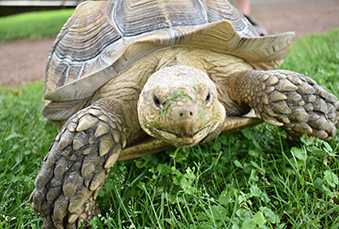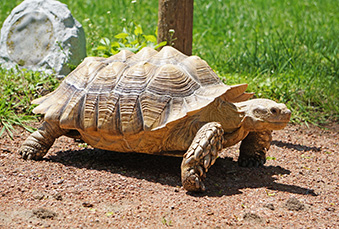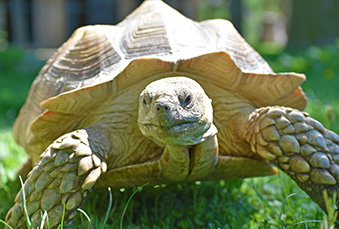Geochelone sulcata | African spurred tortoise or Sulcata tortoise
Name: Groot (Male)



Meet Groot
Sturdy, slow-moving, and seriously cool—Groot is our Sulcata tortoise ambassador, and there’s a lot more to him than just a tough shell. Native to the hot, arid regions of Africa, Sulcata tortoises are the third-largest tortoise species in the world—and the largest mainland tortoise on Earth. Groot may not win any races, but he’s living proof that slow and steady is the key to thriving in some of the harshest habitats on the planet.
Adapted for the Arid Life
Sulcata tortoises are perfectly adapted to life in dry, scorching environments. In the wild, they roam across deserts and savannahs, grazing on grasses, succulents, and hardy shrubs. Their survival strategies are as impressive as they are effective:
- Burrow Builders: Sulcatas are expert diggers, creating underground tunnels—sometimes over 10 feet deep—to escape extreme heat, cold, and conserve moisture.
- Water-Wise Diet: They feed on moisture-rich plants to stay hydrated even when water is scarce.
- Hydration Hoarders: When water is available, they can drink up to 15% of their body weight in one go.
- Armor-Like Skin: Thick scales and tough skin reduce water loss and help shield them from predators and the elements.
At the zoo, Groot enjoys a carefully balanced diet of vegetables, tortoise pellets, and occasional fruits, designed to mirror his wild diet and support long-term health.
What's in a Name?
The name Sulcata comes from the Latin word for “furrowed”, describing the grooved appearance of their shells. The “spurred” part refers to the prominent, cone-shaped scales on their hind legs—thought to help defend against predators and assist in digging.
Built to Last
Sulcata tortoises aren’t just large—they’re long-lived. In the wild, they can live 50 to 70+ years, and in human care, some have reached over 100! Groot is in it for the long haul.
In addition to their resilience, Sulcata tortoises are deeply respected in many African cultures. In Senegalese traditions, for example, they are symbols of:
- Virtue
- Happiness
- Fertility
- Longevity
Some cultures even view them as spiritual intermediaries between the living and their ancestors—a testament to the reverence these animals inspire.
Not a Pet: Why Sulcatas Don’t Belong at Home
With their gentle demeanor and unique appearance, Sulcata tortoises like Groot are often sold in the exotic pet trade. But despite their popularity, these giants are not suitable pets for most people. Many new owners are unprepared for the long-term responsibility involved, leading to widespread neglect and abandonment.
Here’s what many don’t realize:
- They get BIG: Adult Sulcatas can weigh 200 lbs and need large, secure outdoor enclosures.
- They’re powerful diggers: Their burrowing habits can damage fences, gardens, and even home foundations.
- They live for generations: With lifespans exceeding 100 years, many outlive their owners.
- They require specialized diets: Poor nutrition can lead to severe health issues like shell deformities and organ failure.
- Veterinary care is complex: Not all vets specialize in reptiles, and treatment can be costly and hard to find.
Many Sulcatas raised in homes suffer from improper housing, poor diets, and a lack of stimulation. Some are released into parks or wild spaces, where they can’t survive and may harm native ecosystems.
If you’re interested in tortoises, check out the Not-a-Pet campaign to learn more about why these reptiles are best left in expert hands. For experienced reptile keepers with the space, resources, and commitment required, adopting from a reputable rescue is the most ethical option. Never purchase wild-caught animals.
Fact Sheet
Taxonomy
Genus: Geochelone | Species: sulcata |
Kingdom: Animalia | Phylum: Chordata | Class: Reptilia | Order: Testudines | Family: Testudinidae |
Favorite Enrichment Type
Sprinklers, digging in dirt/sand/mulch.
Diet
- In the Wild: Primarily eat succulent plants, grasses, and shrubs.
- At the Zoo: Vegetables, fruit, and specially formulated tortoise pellets.
Life Span
- In the Wild: 50 to 70+ years
- In Human Care: 80 to 100+ years
Geographic Range
They are native to Africa, found along the southern edge of the Sahara Desert from Senegal and Mauritania, east through Ethiopia.
Habitat
Desert and dry savannah.
Tortoise Tidbits
- Adult Sulcatas can weigh over 100 pounds!
- They dig with powerful shovel-like front legs.
- Their shell is part of their skeletal system, fused to their spine and ribs.
- Tortoises don’t swim—unlike turtles, they’re strictly land dwellers.
- They can survive for weeks without drinking if their food provides enough moisture.
Status: Endangered
Conservation Matters
Sulcata tortoises are listed as Endangered on the IUCN Red List. Their populations are declining due to:
- Habitat loss from agriculture and urban expansion.
- Overgrazing by livestock, reducing food availability.
- Climate change, which worsens desertification.
- Illegal pet trade, which removes individuals from the wild and often places them in poor conditions.
Love Tortoises? Here’s How to Help:
- Support AZA-accredited zoos and sanctuaries that provide responsible care for reptiles.
- Say NO to exotic pet sales from breeders, pet stores, or unregulated markets.
- Educate others on why wild animals don’t belong in homes.
- Choose adoption for domestic animals instead of purchasing exotic ones.
By learning about Groot and his wild cousins, you’re already making a positive impact. Let’s work together to keep tortoises like him wild, safe, and thriving for future generations.
How to Find Me
You’ll find Groot movin’ and groovin’ in our Outback habitat with his Leopard tortoise friends. He may be soaking up the sun or just doing his favorite thing—eating!
